 |
||
|
||
| ||
Introduction to the theory of colorsThe AOpen company is known for some time already by the exclusive models of motherboards, whose features are unusual color of PCB or precious metals depositions more suitable for jewellry - gold, platinum made on chips' heat sinks. This time we got two item in our laboratory - AX3S Pro, fulfilled on Intel 815E system logic, and AX34 Pro II on the basis of Via Apollo 133A chipset. Perfectly understanding that these products are not new, as boards on these chipsets have been released by almost everyone, we shall try in this browse to observe them not only from the point of their functionality, but also from a point of their consumer qualities - there are some features that outstand them from the common yellow-green majority. Now, with the help of Aopen, it is possible to speak not only about card's settings, or about its qualitative and quantitative metrics but, perhaps, for the first time, even about its appearance - about the design of card. Certainly it's not the first experience of engaging the client not only at the expense of the perfect characteristics of the product - there were lone attempts to attract clients with something interesting and more often it was an unusual color of card. And another important moment: motherboards were sold not only inside PC cases, but also in retail-packing that usually was bright and colorful, what could not be told about the thing that laid inside. And on the one hand it was strange - you see what is sold should have attractive appearance, but on the other hand - it seems useless as the motherboard will not lay on some outstanding place like desktop and decorate the surroundings. Its task is to be in dusty case and work, reminding about itself as little as possible, i.e. work fast enough and without failures. But not many people paid attention to the fact that motherboard "spends" some time in the hands of the customer - and it is necessary to attract him to be selected among all "sisters" with similar characteristics - and after this had been noticed in Aopen, the rest was just engineering - to cover termazote with the different color, deposit the gold on the heat sink - and voila, the sight of the buyer stays on their product :). The situation very much reminds of the first contacts of Europeans with Indians or any low-civilized peoples - in exchange for beads pioneers received much more valuable things, and here in exchange for brilliant heat sinks the company receives buyers - and one shouldn't feel offended, as due to this we have possibility not only to tell about the card's operation and characteristics, but also to look at it as on the complete solution, combining both design and quite good functionality. For the AOpen company such approach means that the person who once purchased maybe not a first-rate quality product (I mean not the failsafe operation, as the majority of manufacturers provide it, but vast possibilities of system configuration and a set of other nice features), but who is still satisfied by its operation - most likely he will buy their production further. Another holiday is at hand - St. Valentine's day, still not very habitual for us, and by this day the company has pleased us with two motherboards mentioned earlier, and if the AX34 Pro II does not cause a "storm" of delights anymore, as it is fulfilled in already usual silver/black colors, the second motherboard, namely AX3S Pro, became a surprise for us, as it is made in unusual for my imagination pink color. My imagination is not poor, but still it's not enough to make a motherboard pink :) And one more thing. Saying "pleased us" I mean our lab, as the boards themselves have been announced already long ago. It is natural to present gifts on St. Valentine's day and everyone would like to please the object of his passion and express his feelings. So now the choice of gifts is wider due to a pink motherboard from AOpen company that is , by the way, a heart of computer itself. :) We also have two motherboards according to holiday - pink for ladies, and black for gentlemen. As there are plenty of tests of similar boards, and it is not our main purpose today, I shall allow myself to remind the reader of the holiday. This will not be original, understanding that half of the Internet will be filled with similar stories, but the day demands, so to say :) The holiday, as it is today, exists since 496 AD when the Pope Gelasius has announced this day the St. Valentines's day. And the story itself took place in 296 AD, when the emperor Claudius II decided to conquer the world. During that time Roman empire lacked soldiers, and the emperor decided that it was coupled to marriages and has prohibited weddings. It was naturally unpleasant for many people, including the bishop Valentine, who continued to wed couples and lost his head for this. The execution of Valentine was held on 14th February 270 AD. Since that time there appeared a tradition write letters to beloved and to present them gifts. Naturally this holiday is good for our two unusual motherboards from AOpen that can be a gift themselves. Boards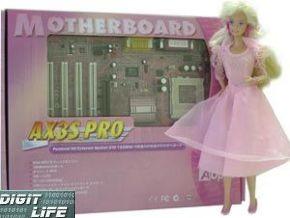 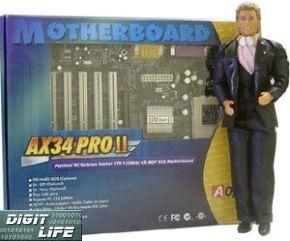 And let's talk about boards, less detailed than usually at the expense of chipset descriptions. Both products are well known already, and we wrote about them before, and in case with AX3S Pro we already wrote about its AX3S predesessor. There were no serious changes in this case, and today's representative of Intel 815E chipset from AOpen is more alike the tuning of the old version than new product, but it doesn't make it uninteresting for an article. As the boards are presented by one company, they have much in common - similar packing, the same set of free software, the identical set of cables and technologies used by the manufacturer. So there's no need to describe the same things twice - one description will be enough. And now I shall give you specifications of the boards. A board for ladies: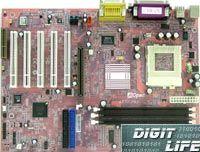 
As we see, a standard enough set for the motherboard on the basis of Intel 815E system logic, but there's nothing unusual, all is limited by chipset, and features developed by company will follow. The processor is surrounded by 8 Low ESR heat condensers of 2200 uF capacity that differs from AX3S - the stability should increase, but at the same time there are problems with coolers, as the "native" cooler from Intel Pentuim III 1GHz CPU, that is rather big or a cooler from GlobalWin had no enough place, and Chrome Orb from Thermaltake, that is rather usual now, has been installed with no problems. The board itself has good mount design, maybe CD-in and Aux-in plugs, that can be overlapped by PCI or AGP cards. There's a nice latch on the AGP slot that makes it impossible for a card to fall out, like in some cheap low-quality PC cases. The heat sink of chipset's northern bridge is pink and that suits the surroundings. That's all in general, except for maybe not very successful IDE plugs layout - they are located behind the first PCI slot and, theoretically, can prevent insertion of some big card - but that doesn't happen usually and this slot is kept empty for the better air circulation around the videocard. On board there are only system bus frequency switches - 66,100 or 133 MHz, all other settings can be made from BIOS Setup. In the box, designed habitually enough for AOpen, (except for the pink color) the boards lays in the plastic case. There are two software CDs in the package - one with becoming usual Norton Antivirus 2000, the second has motherboard drivers, the manual in PDF format and Adobe Acrobat Reader 4.0 to read it. Besides, there's a rather thick user's guide and a brief instructions poster of A2 format. Unfortunately ours was in Japanese language and therefore was useless for us. The set of cables consists of one ATA100, one ATA33, FDD cable and a metal plate for the back panel with two additional USB plugs. There is also a cable substituting the jumper for settings the BIOS. Packages for both boards are identical, therefore I shall not describe them anymore. 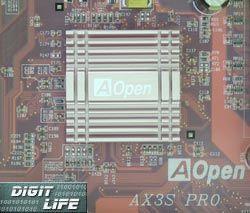 DieHARD BIOS already familiar to us, is used in these boards. It consists of two flash-memory chips duplicating each other to avoid such problems as BIOS contents damage as a result of incorrect patches or effects of viruses - such technology have appeared as a result of massive viruses attacks, and first of all due to infamous WinCIH. The company goes further than others again and offers us the possibility to choose the flash chip to boot a computer from - for this purpose it has made a switch on the back panel of the computer, it has three positions: Normal - for normal booting, Rescue - for booting from the alternative chip for the subsequent copying of its contents to the first flash chip, and a midposition - the computer won't boot at all to prevent ROM data corruption, as stated by the company. 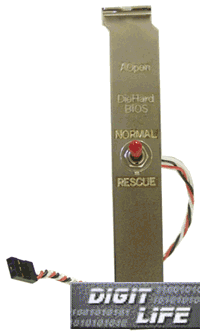 Dr. LED is another company's technology, by means of which it is possible to watch the system booting. You just need to plug in the indicator panel inserted into 5.25 " bay and watch its eight light emitting diodes indicating booting status of the following devices (they are the same as for Dr. Voice): keyboard, FDD, HDD, CPU, memory, cards in AGP and PCI slots. At usual system boot-up all diodes light up, and the one indicating system's serviceability lights up the last, in case of any problems the last diode show with what devices there were problems. TweakingAs in case of the majority of modern motherboards, all system tuning is held via BIOS Setup, where it is possible to fine-adjust memory timings, to change power on CPU kernel with the step of 0.05V, and also to change the FSB - the list of available frequencies follows - on the base of 66 MHz: 66.6, 66.8, 68.3, 75.3, 78 and 80 MHz, on the base of 100 MHz: 95,100,100.2,105,110,114,117,122,127,129,133.3,133.6,138,140,150 MHz, on the base of 133MHz: 122,133.3,133.6,138,140,146.6,144,150,166 MHz. Though the list is long, it's not unusual or outstanding - plenty of boards can grant much more possibilities, such as FSB change with the step of 1MHz in the range from 66 up to 200MHz. The impossibility to manually set frequency ratios between FSB/SDRAM/PCI and impossibility to change power for chipset and memory make this motherboard not so good for tweaking, but I don't think it was designed for it. The variant for men: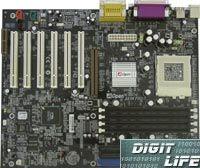 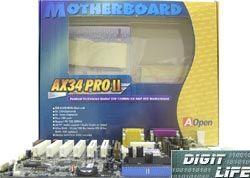
Nothing unusual here, I shall tell more about the board. The box design is usual, the only unconvenient things are the ATX power supply plug, situated between the CPU socket back panel, and impossibility to insert memory modules with a videocard already installed. No more about CD-in plug, etc., it seems that motherboard manufacturers agreed among themselves to place them in front of PCI slots - and the assembly place is not so convenient. The processor is still surrounded by even more heat sinks than on the previous board - here are 10 of them of the same capacity. But their layout allows to install monstrous cooler heat sinks like those from GlobalWin as well as those Sanyo coolers, included in packages with last Intel's processors. There are the same jumpers on board as on AX3S Pro: FSB 66,100,133 MHz, USB plugs, GPIO (General Purpose Input/Output), Dr. LED, IrDA, WOM (Wake on Modem). The boards only lacks jumpers for choosing language of Dr. Voice feature, however described on the web-site. Our board must have been of the earlier revision. But as such feature exists, I shall briefly describe it. Dr. Voice - one the company's technologies used to help user understand what problem occurred on the computer in case of system lockdown and, besides, to make the board more outstanding as a product. The company was not first to offer such technology, but it has gone further than competitors, allowing user to set jumpers for 4 languages: English, German, French or Chinese, so in case of a problem user will be notified about it in the one of the above languages. A list of "problematic" events is also longer than those of competing technologies of other companies - there are 7 of them: keyboard initialization error, processor, memory, FDD, HDD and cards in AGP and PCI slots. The heat sink of chipset is made from aluminium, and there are no gold depositions, there's only an AOpen trade mark. The board's package is completely identical to the first board, the difference is only in language, on which everuthing is written - in the first case it was Japanese, here the user's guide was in English. 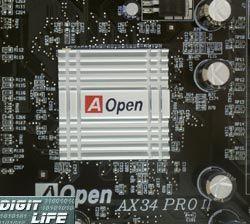 TweakingAs well as the previous board, this model is not to be "super-tweaked", everything is realized via BIOS, there is no possibility to manually change FSB/SDRAM/PCI ratios, there is no processor and memory power level regulation possibility, the list of frequencies is even smaller: 66.8,75,83.3,90,95,100,105,110,112,120,124,133,140 and 150MHz, and there's also a possibility to change power of CPU kernel with the same step of 0.05V. So, as the boards are described, the only thing left is their permomance. PerfomanceThe following equipment has been used for perfomance tests:
And software:
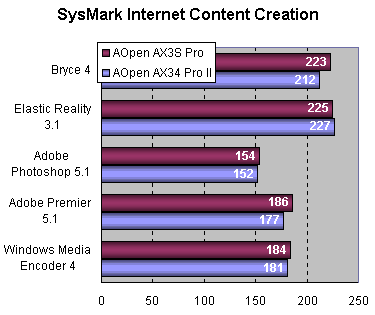 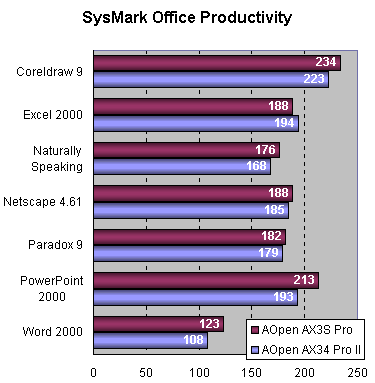 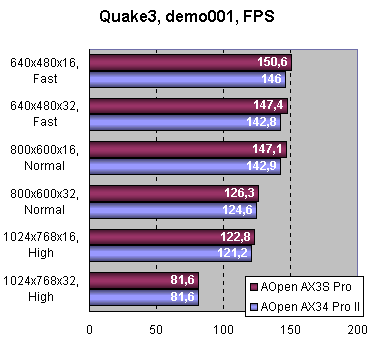 Conclusions It is now possible to draw some final conclusions of today's testing - the boards are undoubtfully good, as well as the whole exclusive product line from AOpen, though we can't say we get the highest perfomance or vast tweaking possibilities for our money, but some additional dollars spent for these boards, comparing to generally average boards, will obviously satisfy the buyer. And speaking about perfoamnce - the variant for ladies shows better results as always, not because of the pink color, but because of the chipset. That's right, children and women must get all the best things :) And about the pink and black color of boards - it is pleasant to understand, that you own the thing that isn't own by many, so to say - here's the individuality previously impossible to express via computer interiors :) I wish there also was a transparent case with backlight, and: But all this will be about absolutely other money, and the board from AOpen is available already now. It's not a masterpiece like cases made according to individual projects, i.e. from expensive types of trees, but already close to that. The Art is being pushed into masses, so to say. We shall just wait, such things may become a part of mass production and not a product of enthusiasts from one company. Write a comment below. No registration needed!
|
Platform · Video · Multimedia · Mobile · Other || About us & Privacy policy · Twitter · Facebook Copyright © Byrds Research & Publishing, Ltd., 1997–2011. All rights reserved. |